


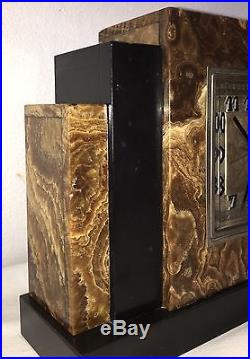



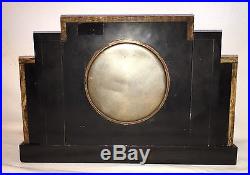
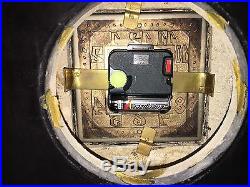

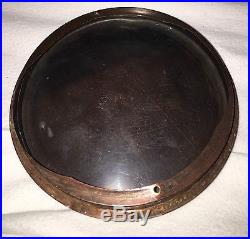
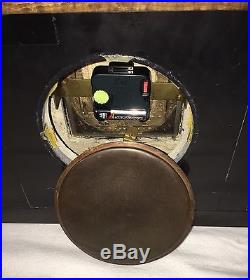

Wonderful Estate Sale Find! Beautiful ATO Leon Hatot Art Deco Rare Mantel Clock 1920’s Antique Made in France Rewired: meaning, No original movement replaced with battery type movement. Although the original movement has been replaced, this heavy 20.5 pound mantel clock is a masterpiece! The art deco design and the craftmanship are amazing. Truly, one of a kind piece. 13 5/8″ wide x 9 1/8″ tall x 3 1/2 deep. There are a few chips in the marble so please see all photos. Please note that most of our items are vintage, meaning older, and have had homes before I found them. We try to describe our items well and take several pictures. Ook at all photos carefully for more details. Please ask any questions before purchasing. All questions are promptly answered. Ourvintagepicks or by user name. Léon Hatot and ATO electric clocks. English text by Ian Richardson. This article was previously published in French in the bulletin Chronométrophilia. No 56 (summer 2004). The chapter headed “History” in the present article is largely composed of extracts from the internet site “Worldtempus”, with grateful thanks to the International Centre of Horological Documentation(CIDH). Born on the 22nd April 1883 at Châtillon Sur Seine, died on the 11th September 1953, Léon Hatot was a student at the School of Horology in Besançon between 1895 and 1898, then at the École des Beaux-Arts in Besançon. In 1905, at an early age, he set up his own business specialising in engraving watch cases which grew rapidly into a workshop employing artisans making high quality clocks in precious metals and jewels. He later established himself in Paris where, in 1911, he move in with the firm “Bredillard”, while keeping his workshop in Besançon. He was then, and for a while afterwards, one of several creators of artistic clocks and jewellery, supplying the main dealers in the rue de la Paix. In “La France Horlogère” in 1920 the Council includes, under specialist contributors, «Hatot Industriel et Artiste Bijoutier» or “Hatot, Industrial and Artistic Jeweller”. A questioning and visionary spirit, Léon Hatot interested himself very early on in the subject of electrical horology and, in 1920, founded a separate division for research and development of clocks and watches powered by electric cells. In the same year, his businesses both in Paris and in Besançon were amalgamated as a single company: “Société des Etablissements Léon Hatot”. To assist in the research and development of electrical horology, in 1923 he collaborated with Marius Lavet, an engineer in Arts and Crafts at the Ecole Supérieure d’Electricité and who, like himself, was passionately interested in the applications of electricity in horology. Trading under the name “ATO” from 1923, electric clocks were produced in Besançon in a partially rebuilt factory in the rue de la Rotonde. They were an immediate unprecedented success in the market place. At the Exposition Internationale des Arts Décoratifs in 1925, Léon Hatot won a Grand Prix for a whole range of electric clocks, housed in marble, chrome, marquetry and fine wood cases, even in some instances in cases of moulded glass from the famous Lalique factories Fig. Léon Hatot was decorated with the Legion of Honour and nominated as a judge in the commercial tribunal in the Seine as well as being a consultant in foreign trade. In 1929, Léon Hatot made a significant invention with the automatic winding watch “ROLLS”. In this device, the movement is wound by the motion of an arm sliding inside the case, guided by balls between two runners original Patent No. 704.910 of 11 January 1930, first amendment No. 38.984, second amendment No. 39.523, completed on the 30th November 1931 by a third amendment No. This invention was described by his friend Marius Lavet in the Bulletin of the Société d’Encouragement pour l’Industrie Nationale. This mechanism had the advantage of working with the minimum of friction and permitted the manufacture of movements of extremely small size, perfectly adapted to rectangular watches which were in fashion at the time – particularly for ladies watches. A contract dated 23rd September 1930 was drawn up between the Hatot company and a Monsieur Blancpain giving exclusive manufacturing rights and sole distribution right within France and Belgium for the autowinding “ROLLS” watches. Despite this invention, crowned by a Medal of Honour by the Société d’Encouragement pour l’Industrie Nationale, it did not yield the success it deserved as its commercial exploitation was affected by the world economic crisis of 1929. Throughout this time, Léon Hatot maintained his workshop for jewellery and highly decorated watch cases in Paris which, in 1926, he put under the control of Edouard Dietsch who became engaged to his daughter. The works then found a new period of growth which, helped by the sales of ATO electric clocks, financed the very expensive research into electrical horology which Léon Hatot pursued with his friend Marius Lavet – research which was spectacularly rewarded by the invention of the electric clock “ATO-RADIOLA” which received correcting time signals by radio waves. Described for the first time in May 1928 in issue No 2 of “Radiola”, a publication of the French Radio Society (la Société Française Radioélectrique), the correcting signal was applied remotely over a distance of 250 kilometres by a radio signal transmitted from the Eiffel Tower or by Radio Paris during one of their concert broadcasts. It was said to be enough for the clock’s owner to listen to one of these concerts at least once per week for the clock to be maintained at exactly the correct time. It is interesting to note that this device was “reinvented” and launched amid much publicity by Junghans at the end of the 1980’s. The most significant part of this latter was the power of the transmitter, connected to the Observatory at Brunswick, whose signal carries almost 2,000 km. That part of the business was transferred to a far more salubrious location at 12 Faubourg Saint Honoré which was soon frequented by a very particular clientele, rich and exacting, attracted by the range of high quality, highly decoarated watches which Edouard Dietsch had made his speciality. This new prosperity was, however, short-lived. In common with all luxury industries, they were direct casualties of the economic crisis which followed the Wall Street Crash of 1929. By extending his export activities into Italy, Belgium and Germany, where he established agreements with Haller & Benzing and HAC (a company eventually taken over by Junghans) Fig. For the manufacture and distribution of ATO clocks, Léon Hatot not only saved his business but succeeded in developing it. Not wishing to desert the Franche Comté completely, he maintained a small assembly workshop in Besançon. His great artistic qualities always made him want to make special pieces. As at the beginning of his career he conceived and realised with his own hands, on behalf of the town of Besançon, a very fine pocket watch which was presented to the French President, Armand Fallières, during one of his visits in Doubs. Later, he designed and modelled the glass trophy presented each year to the horologist who obtained the best results in the annual competition the “Concours de Chronométrie”. He was also a founder member of the French Horological Society. At the Colonial Exhibition of 1931, Léon Hatot displayed electric clocks of very small proportions which were the origin of a new generation of decorative clocks. In particular, he created a new model, the concept and presentation of which were revolutionary, in which he dispensed with traditional decorated cases and made the movement itself the sole decorative element. This paved the way for a whole new fashion which swept along most makers who adopted this “avant garde” using glass and chrome which blended perfectly with the furniture of the day. His fertile imagination also launched onto the market other original creations such at the “Aquatora” in which the time was shown on the circumference of an illuminated aquarium and the “Maplux” where the time anywhere in the world was shown along the equator of a terrestrial globe. In parallel with his production of electric clocks, in 1933 Léon Hatot opened a new department for time distribution systems by means of a “master clock” which controlled several “slave clocks”. This was done by taking over the business of Paul Garnier, founded in 1825 which specialised in time distribution at railway stations and public buildings. The transference of the factory at Besançon was at last decided upon, and the different services of the company were regrouped in the premises of Paul Garnier at 9, rue Beudan in Paris. In 1939, from the beginning of the Second World War, the Hatot company was requisitioned for the production of Sperry gyrocompasses and other instruments for aviation (as the example of an altimeter shown below) as well as various navigational aids for the French Navy. The surrender in 1940 put an end to these activities as Léon Hatot refused any form of collaboration with the Germans. Aircraft altimeter for the French Air Force, WWII. It is indeed regrettable that he did not see the technical revolution to which horology underwent following the application of the transistor to this industry. Only days before his death, he knew of the first prototypes working in laboratories without any electrical contact and he foresaw their eventual success. Léon Hatot’s whole life was dedicated to research into getting the best out everything he did and his extraordinary activity, his strong will, his inventive genius always in evidence enabled the business to prosper and, despite its modest size, influence much larger horological companies throughout the world. The Hatot Company was among the first to embody in their instruments important improvements made possible by the application of transistors in horology Fig 14. Their first patents were filed on 16th September 1953, but the Hatot Company did not have sufficient funds to exploit their numerous patents worldwide, so they granted licences to several of the principal horological producers in the industrialised countries which is why there exist throughout the world millions of watches and clocks signed L. , Westclox, Smith & Son, Bulova, Jaz et General Time, all carrying the words Lic. It was the same for the Chronostats I, II and III, electronic marine chronometers which were supplied by L. To the French Navy, the Ecole Normale Supérieure, la Compagnie Générale Transatlantique and the Institut de Physique du Globe. Chronostat III in particular was used for polar expeditions and was installed in Navy buildings and on the most prestigious vessels including the aircraft carriers “Clémenceau” and “Foch, the helicopter carrier “Jeanne d’Arc”, and various submarines of the “Daphné class. Eventually, following a decision by the Secretary General of the Merchant Navy dated 31st July 1959, the Chronostat III was derestricted and made available for use on liners and merchant ships, not only on the prestigious liner “France” and the splendid “Sovereign of the Sea” but also on numerous oil carriers and container ships of the Shell company. Léon Hatot died on the 11th September 1953 at the age of 70, following a long illness after a life overflowing with activities in art, where he distinguished himself in the field of horology as one of the Masters of the Art-Deco period, and in science where his creative and visionary spirit gave birth to several inventions which heralded the development of horology in the third quarter of the 20th Century. In 1967, the electrical horology branch of Lepaute took over the ATO production. A new type of seven segment digital clock was developed in 1978 and was immediately taken up by the French railways “SNCF”. These clocks achieved such rapid success that they were copied on a grand scale. Although the Hatot Company adopted new production techniques and used miniature quartz crystals as time standards, the costs of research and development could not be recovered in small to medium series production. Competition from South East Asia forced the Hatot Company to abandon its industrial branch and concentrate on the sale of quality watches and domestic battery electric clocks marketed under the names “ATO-LEPAUTE” and “ATO – PAUL GARNIER”. Drawing by Léon Hatot, from the Art-Déco period. The item “ATO Leon Hatot Art Deco Rare Mantel Clock 1920’s Antique Made in France Rewired” is in sale since Sunday, July 16, 2017. This item is in the category “Collectibles\Clocks\Antique (Pre-1930)\Shelf, Mantel”. The seller is “us2013.jenn” and is located in New Port Richey, Florida. This item can be shipped to North, South, or Latin America, all countries in Europe, all countries in continental Asia.
- Country/Region of Manufacture: France
- Case: Marble Silver Plated Metal Glass

